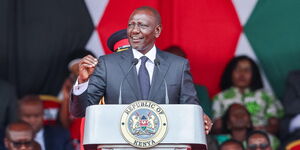Kenya’s economic standing faltered against its close East African Community (EAC) neighbours, Uganda and Tanzania, according to the inflation ranking done by International Monetary Fund (IMF) World Economic Outlook (2023).
In the report, Kenya recorded an inflation rate of 7.38 per cent and was ranked at position 100 globally.
Tanzania, on the other hand, recorded the lowest inflation in EAC registering 3.96 per cent and ranked 161 globally while Uganda had 6.44 per cent emerging 19 positions above Kenya on the global standing.
Apart from Kenya having a high inflation rate, it was also ranked position 64 globally on the debt to Gross Domestic Product (GDP) ratio which stood at 68.4 per cent.
According to Wisevoter, an international research firm, high inflation was worrisome to countries seeking economic prosperity.
“Since inflation is a persistent increase in the overall price level of goods and services in an economy over time, it is the most watched economic indicator as it affects the purchasing power of a currency,” the international firm explained.
The firm further revealed that a high inflation rate harms economic growth by reducing consumer purchasing power, causing uncertainty, and leading to higher interest rates.
Expert Input
Speaking to Kenyans.co.ke, renowned economist Vincent Kimosop noted that the data from IMF showed that Tanzania and Uganda had a lower cost of living compared to Kenya.
Kimosop, however, warned that the inflation rate alone should not be used to ascertain that Tanzania and Uganda’s economies were better than Kenya’s.
“Inflation rate is generally measured by taking a basket of goods and checking its prices and getting their average.
“To get a full picture of the economic state of a country, you look at all macro prices which are; interest rates, exchange rates and inflation,” he explained.
On the exchange rate, Ugandan shilling continued to gain strength against Kenya's.
In June 2022, the exchange rate for Ksh1 was Ush32 and in 2023, Ush had gained strength and was at Ush26 for Ksh1.
Similarly, Tanzanian currency was quickly gaining strength on Ksh with Ksh1 exchanging at Tsh21 in May 2021 and Tsh17 in June 2023.
Kimosop, therefore, observed that examining what was causing pressure on the Kenyan Shilling was prudent, including speculative factors.
The economist also noted that the 2022/2023 drought, the worst in 40 years, could have given Uganda an advantage as both economies are largely agriculture driven.
“Uganda is a food surplus country. In terms of the cost of living, it is relatively cheaper in those (Tanzania and Uganda) countries,” he stated.












